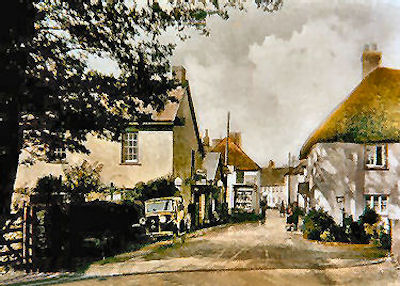

|
This site was designed with the intention of providing a detailed history of the village and parish of Witheridge. A great deal of hard work by a small, but dedicated team, has led to the accumulation of a large quantity of material which is available for study. Items include the first digitally mastered copy of the 1837 Tithe Map for Witheridge and its Outliers, and this will also be made available for research. Copies of the 1841, 1851, 1861, 1871 and 1891 Census are now also held by the archive, along with that for 1901, and we hope to complete the list with that for 1881 shortly. Over the years, a number of records which have been obtained by members of the team have been passed to the County Records Office to ensure that they are preserved for future generations. Witheridge, occupied by man for several thousands of years, is set amidst un-spoilt undulating countryside linked by two rivers, the Little Dart and the Adworthy Brook. Situated at a height of 600 feet above sea level, and set on rolling hills in the beautiful Country side of North Devon, with Exmoor National Park to the North, and Dartmoor National Park a short distance away to the South. It is an enchanting, often forgotten region of the county, with many wooded valleys associated with the path of the Little Dart River, and a variety of beautiful countryside scenes, rolling hills, hidden woodlands, and spectacular scenery, all of which give it a remote and tranquil feeling difficult to find elsewhere these days. Many of our farms appeared in the Domesday Book of 1086. In earlier times, Bronze Age people grew crops, and raised their funeral mounds on Witheridge and Dart Raffe Moors, and before them Stone Age folk left flint flakes in the soil for us to find. The material on this site spans the centuries with a range of events - in the 13th century there were a couple of grim murders, in the 14th we felt the effects of the Black Death, and the Reformation saw us acquire five church bells from a priory in Barnstaple. Some Witheridge men played a part in the Civil Wars, and at that time others lost their lives in an attempt to steal hidden treasure. The 18th Century had a local man, William Chapple; describe the parish in detail in his reply to the Milles Inquiry. At the end of the 1700s, our first school was established, and in the 1830s, an extra section was added to the church tower. In 1839, the Witheridge Union Society formed, and the new Turnpike road to South Molton and Tiverton passed through Witheridge. In 1848, new Church and Chapel Schools came. Later, in spite of our efforts, the railway never came, but this led to the success of our two carriers, and the Transport Company they formed together. The 1914-1918 war hit us hard, and afterwards some emigrated, following in the steps of those who had gone in the reign of Edward VII. Locals and evacuees alike remember the 1939-1945 war. Afterwards, the population fell below 700 for the first time for 200 years. Since then it has doubled, and today we have a thriving community, with employment, new housing, community facilities and a range of organisations. People here have always had a certain independence of mind, and we look forward to the future with confidence. If you have enjoyed your visit, please consider leaving a message in Our Guestbook Previous Last Edited 27/02/2008 Copyright © 2000-2006 Witheridge Unless otherwise indicated on the page in question, the photographic images reproduced on this site belong to the Witheridge Archives, and, as such may not be reproduced for commercial purposes without written permission. However, you are welcome to use any of the photographs belonging to the archive for personal and/or non-commercial use. Any material shown as not being owned by the archive may not be reproduced in any form without first receiving written permission from the owner of the material in question. |



